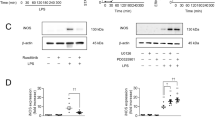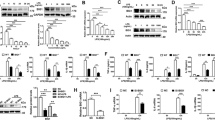Abstract
Toll-like receptor-4 activation by lipopolysaccharide (LPS) induces the expression of interferon-β (IFN-β) in a MyD88-independent manner. Here we report that mice devoid of the JAK protein tyrosine kinase family member, Tyk2, were resistant to shock induced by high doses of LPS. Basal and LPS-induced expression of IFN-β and IFN-α4 mRNA in Tyk2-null macrophages were diminished. However, Tyk2-null mice showed normal systemic production of nitric oxide and proinflammatory cytokines and the in vivo response to tumor necrosis factor (TNF) was unperturbed. IFN-β–null but not STAT1-null mice were also resistant to high dose LPS treatment. Together, these data suggest that Tyk2 and IFN-β are essential effectors in LPS induced lethality.
This is a preview of subscription content, access via your institution
Access options
Subscribe to this journal
Receive 12 print issues and online access
$209.00 per year
only $17.42 per issue
Buy this article
- Purchase on Springer Link
- Instant access to full article PDF
Prices may be subject to local taxes which are calculated during checkout






Similar content being viewed by others
References
Beutler, B. & Rietschel, E.T. Innate immune sensing and its roots: the story of endotoxin. Nat. Rev. Immunol. 3, 169–176 (2003).
Bogdan, C. Nitric oxide and the immune response. Nat. Immunol. 2, 907–916 (2001).
Dobrovolskaia, M.A. & Vogel, S.N. Toll receptors, CD14, and macrophage activation and deactivation by LPS. Microbes Inf. 4, 903–914 (2002).
Poltorak, A. et al. Defective LPS signaling in C3H/HeJ and C57BL/10ScCr mice: mutations in Tlr4 gene. Science 282, 2085–2088 (1998).
Akira, S. Mammalian Toll-like receptors. Curr. Opin. Immunol. 15, 5–11 (2003).
Horng, T., Barton, G.M., Flavell, R.A. & Medzhitov, R. The adaptor molecule TIRAP provides signalling specificity for Toll-like receptors. Nature 420, 329–332 (2002).
Yamamoto, M. et al. Essential role for TIRAP in activation of the signalling cascade shared by TLR2 and TLR4. Nature 420, 324–329 (2002).
Kawai, T., Adachi, O., Ogawa, T., Takeda, K. & Akira, S. Unresponsiveness of MyD88-deficient mice to endotoxin. Immunity 11, 115–122 (1999).
Kawai, T. et al. Lipopolysaccharide stimulates the MyD88-independent pathway and results in activation of IFN-regulatory factor 3 and the expression of a subset of lipopolysaccharide-inducible genes. J. Immunol. 167, 5887–5894 (2001).
Pestka, S., Langer, J.A., Zoon, K.C. & Samuel, C.E. Interferons and their actions. Annu. Rev. Biochem. 56, 727–777 (1987).
Decker, T., Stockinger, S., Karaghiosoff, M., Müller, M. & Kovarik, P. IFNs and Stats in innate immunity to microorganisms. J. Clin. Invest. 109, 1271–1277 (2002).
Bogdan, C. The function of type I interferons in antimicrobial immunity. Curr. Opin. Immunol. 12, 419–424 (2000).
Toshchakov, V. et al. TLR4, but not TLR2, mediates IFN-β–induced Stat1α/β-dependent gene expression in macrophages. Nat. Immunol. 3, 392–398 (2002).
Levy, D.E. & Darnell, J.E.J. Stats: transcriptional control and biological impact. Nat. Rev. Mol. Cell Biol. 3, 651–662 (2002).
Shimoda, K. et al. Tyk2 plays a restricted role in IFN α signaling, although it is required for IL-12–mediated T cell function. Immunity 13, 561–571 (2000).
Karaghiosoff, M. et al. Partial impairment of cytokine responses in Tyk2-deficient mice. Immunity 13, 549–560 (2000).
Fantuzzi, G. et al. Effect of endotoxin in IL-1 β-deficient mice. J. Immunol. 157, 291–296 (1996).
Kobierski, L.A., Srivastava, S. & Borsook, D. Systemic lipopolysaccharide and interleukin-1β activate the interleukin 6: STAT intracellular signaling pathway in neurons of mouse trigeminal ganglion. Neurosci. Lett. 281, 61–64 (2000).
Mattner, F. et al. Treatment with homodimeric interleukin-12 (IL-12) p40 protects mice from IL-12–dependent shock but not from tumor necrosis factor α-dependent shock. Infect. Immun. 65, 4734–4737 (1997).
Pfeffer, K. et al. Mice deficient for the 55 kd tumor necrosis factor receptor are resistant to endotoxic shock, yet succumb to L. monocytogenes infection. Cell 73, 457–467 (1993).
Rothe, J. et al. Mice lacking the tumour necrosis factor receptor 1 are resistant to TNF- mediated toxicity but highly susceptible to infection by Listeria monocytogenes. Nature 364, 798–802 (1993).
Beutler, B., Milsark, I.W. & Cerami, A. Passive immunization against cachectin/tumor necrosis factor (TNF) protects mice from the lethal effect of endotoxin. Science 299, 869–871 (1985).
Marie, I., Durbin, J.E. & Levy, D.E. Differential viral induction of distinct interferon-α genes by positive feedback through interferon regulatory factor-7. EMBO J. 17, 6660–6669 (1998).
Sing, A. et al. Bacterial induction of β interferon in mice is a function of the lipopolysaccharide component. Infect. Immun. 68, 1600–1607 (2000).
Sato, M., Taniguchi, T. & Tanaka, N. The interferon system and interferon regulatory factor transcription factors – studies from gene knockout mice. Cytokine Growth Factor Rev. 12, 133–142 (2001).
Ohmori, Y. & Hamilton, T.A. Requirement for STAT1 in LPS-induced gene expression in macrophages. J. Leukoc. Biol. 69, 598–604 (2001).
Durbin, J.E., Hackenmiller, R., Simon, M.C. & Levy, D.E. Targeted disruption of the mouse Stat1 gene results in compromised innate immunity to viral disease. Cell 84, 443–450 (1996).
Erlandsson, L. et al. Interferon-β is required for interferon-α production in mouse fibroblasts. Curr. Biol. 8, 223–226 (1998).
Hoshino, K. et al. Cutting edge: Toll-like receptor 4 (TLR4)–deficient mice are hyporesponsive to lipopolysaccharide: evidence for TLR4 as the Lps gene product. J. Immunol. 162, 3749–3752 (1999).
Haziot, A. et al. Resistance to endotoxin shock and reduced dissemination of gram-negative bacteria in CD14-deficient mice. Cell 4, 407–414 (1996).
Nagai, Y. et al. Essential role of MD-2 in LPS responsiveness and TLR4 distribution. Nat. Immunol. 3, 667–672 (2002).
Suzuki, N. et al. Severe impairment of interleukin-1 and Toll-like receptor signalling in mice lacking IRAK-4. Nature 416, 750–756 (2002).
Erickson, S.L. et al. Decreased sensitivity to tumour-necrosis factor but normal T-cell development in TNF receptor-2–deficient mice. Nature 372, 560–563 (1994).
MacMicking, J.D. et al. Altered responses to bacterial infection and endotoxic shock in mice lacking inducible nitric oxide synthase. Cell 81, 641–650 (1995).
Laubach, V.E., Shesely, E.G., Smithies, O. & Sherman, P.A. Mice lacking inducible nitric oxide synthase are not resistant to lipopolysaccharide-induced death. Proc. Natl. Acad. Sci. USA 92, 10688–10692 (1995).
Sato, M. et al. Distinct and essential roles of transcription factors IRF-3 and IRF-7 in response to viruses for IFN-α/β gene induction. Immunity 13, 539–548 (2000).
Deonarain, R. et al. Impaired antiviral response and α/β interferon induction in mice lacking β interferon. J. Virol. 74, 3404–3409 (2000).
Takaoka, A. et al. Cross talk between intferferon-γ and -α/β signaling components in calveolar membrane domains. Science 288, 2357–2360 (2000).
Hirschfeld, M., Ma, Y., Weis, J.H., Vogel, S.N. & Weis, J.J. Cutting edge: repurification of lipopolysaccharide eliminates signaling through both human and murine toll-like receptor 2. J. Immunol. 165, 618–622 (2000).
Supajatura, V. et al. Differential responses of mast cell Toll-like receptors 2 and 4 in allergy and innate immunity. J. Clin. Invest. 109, 1351–1359 (2002).
Hirschfeld, M. et al. Signaling by Toll-like receptor 2 and 4 agonists results in differential gene expression in murine macrophages. Infect. Immun. 69, 1477–1482 (2001).
Navarro, L. & David, M. p38-dependent activation of interferon regulatory factor 3 by lipopolysaccharide. J. Biol. Chem. 274, 35535–35538 (1999).
Shinobu, N. et al. Involvement of TIRAP/MAL in signaling for the activation of interferon regulatory factor 3 by lipopolysaccharide. FEBS Lett. 571, 251–256 (2002).
Servant, M.J. et al. Identification of distinct signaling pathways leading to the phosphorylation of interferon regulatory factor 3. J. Biol. Chem. 276, 355–363 (2001).
Doyle, S.E. et al. IRF3 mediates a TLR3/TLR4-specific antiviral program. Immunity 17, 251–263 (2002).
Magram, J. et al. IL-12–deficient mice are defective in IFN γ production and type 1 cytokine responses. Immunity 4, 471–481 (1996).
Heinzel, F.P., Rerko, R.M., Ahmed, F. & Hujer, A.M. IFN-γ-independent production of IL-12 during murine endotoxemia. J. Immunol. 157, 4521–4528 (1996).
Schindler, H., Lutz, M.B., Rollinghoff, M. & Bogdan, C. The production of IFN-γ by IL-12/IL-18–activated macrophages requires STAT4 signaling and is inhibited by IL-4. J. Immunol. 166, 3075–3082 (2001).
Hochholzer, P., Lipford, G.B., Wagner, H., Pfeffer, K. & Heeg, K. Role of interleukin-18 (IL-18) during lethal shock: decreased lipopolysaccharide sensitivity but normal superantigen reaction in IL-18–deficient mice. Infect. Immun. 68, 3502–3508 (2000).
Shimoda, K. et al. Partial impairment of interleukin-12 (IL-12) and IL-18 signaling in Tyk2-deficient mice. Blood 99, 2094–2099 (2002).
Freudenberg, M.A. et al. A murine, IL-12–independent pathway of IFN-γ induction by gram-negative bacteria based on Stat4 activation by type I IFN and IL-18 signaling. J. Immunol. 169, 1665–1668 (2002).
Nguyen, K.B. et al. Critical role for Stat4 activation by type I interferons in the interferon-γ response to viral infection. Science 297, 2063–2066 (2002).
Car, B.D. et al. Interferon _ receptor deficient mice are resistant to endotoxic shock. J. Exp. Med. 179, 1437–1444 (1994).
Taniguchi, T. & Takaoka, A. A weak signal for strong responses: interferon-α/β revisited. Nat. Rev. Mol. Cell Biol. 2, 378–386 (2001).
Lee, C.-K., Gimeno, R. & Levy, D.E. Differential regulation of constitutive major histocompatibility complex class I expression in T and B lymphocytes. J. Exp. Med. 190, 1451–1463 (1999).
Yamamoto, M. et al. Cutting edge: a novel Toll/IL-1 receptor domain–containing adapter that preferentially activates the IFN-b promoter in the Toll-like receptor signaling. J. Immunol. 169, 6668–6672 (2002).
Oshiumi, H., Matsumoto, M., Funami, K., Akazawa, T. & Seya, T. TICAM-1, an adaptor molecule that participates in Toll-like receptor 3–mediated interferon-β induction. Nat. Immunol. 4, 161–167 (2003).
Lehmann, V., Freudenberg, M.A. & Galanos, C. Lethal toxicity of lipopolysaccharide and tumor necrosis factor in normal and D-galactosamine–treated mice. J. Exp. Med. 165, 657–663 (1987).
Schmidt, H.H., Warner, T.D., Nakane, M., Forstermann, U. & Murad, F. Regulation and subcellular location of nitrogen oxide synthases in RAW264.7 macrophages. Mol. Pharmacol. 41, 615–624 (1992).
Acknowledgements
We thank R. Lajko, M. Deutschmann and G. Constantino for technical assistance, and C. Galanos and B. Strobl for helpful comments on the manuscript. This work was supported by Austrian Science Fund (FWF) grants P15335 (to M.K.), P14945 (to P.K.) and P15272 (to T.D.); by the German Research Foundation (grant DFG 996/3-1 to C.B.); and by the Austrian Ministry of Education Science and Culture (BM:BWK OEZBT GZ200.074/1-VI/1a/2002 to M.M.).
Author information
Authors and Affiliations
Corresponding author
Ethics declarations
Competing interests
The authors declare no competing financial interests.
Rights and permissions
About this article
Cite this article
Karaghiosoff, M., Steinborn, R., Kovarik, P. et al. Central role for type I interferons and Tyk2 in lipopolysaccharide-induced endotoxin shock. Nat Immunol 4, 471–477 (2003). https://doi.org/10.1038/ni910
Received:
Accepted:
Published:
Issue Date:
DOI: https://doi.org/10.1038/ni910
This article is cited by
-
A novel highly selective allosteric inhibitor of tyrosine kinase 2 (TYK2) can block inflammation- and autoimmune-related pathways
Cell Communication and Signaling (2023)
-
Gene profiling of Toll-like receptor signalling pathways in neutrophils of patients with acute-on-chronic liver failure
Journal of Translational Medicine (2021)
-
TYK2 licenses non-canonical inflammasome activation during endotoxemia
Cell Death & Differentiation (2021)
-
Natural and synthetic carbohydrate-based vaccine adjuvants and their mechanisms of action
Nature Reviews Chemistry (2021)
-
Human Disease Phenotypes Associated with Loss and Gain of Function Mutations in STAT2: Viral Susceptibility and Type I Interferonopathy
Journal of Clinical Immunology (2021)



